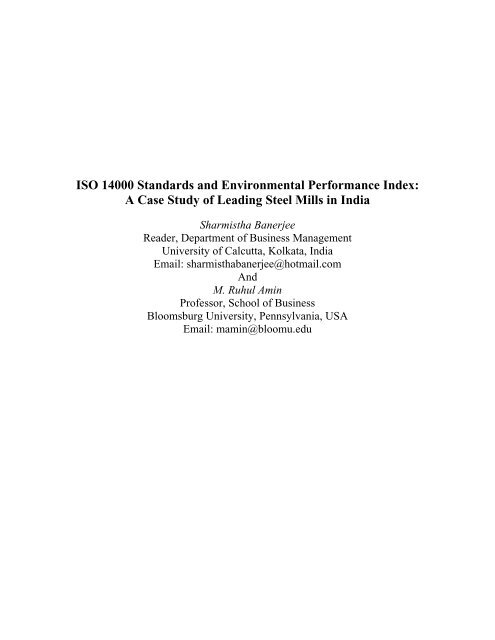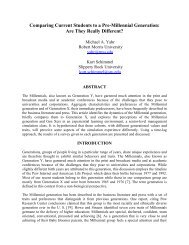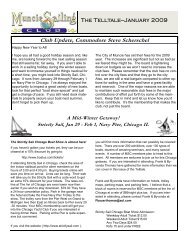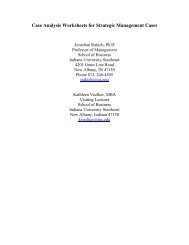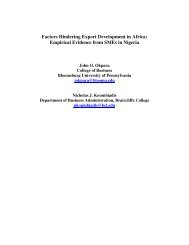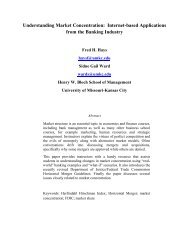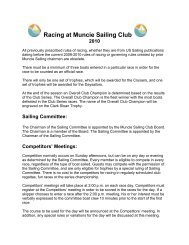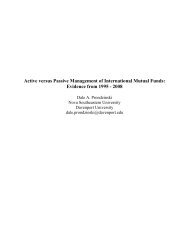ISO 14000 Standards and Environmental Performance Index: A ...
ISO 14000 Standards and Environmental Performance Index: A ...
ISO 14000 Standards and Environmental Performance Index: A ...
You also want an ePaper? Increase the reach of your titles
YUMPU automatically turns print PDFs into web optimized ePapers that Google loves.
<strong>ISO</strong> <strong>14000</strong> <strong>St<strong>and</strong>ards</strong> <strong>and</strong> <strong>Environmental</strong> <strong>Performance</strong> <strong>Index</strong>:<br />
A Case Study of Leading Steel Mills in India<br />
Sharmistha Banerjee<br />
Reader, Department of Business Management<br />
University of Calcutta, Kolkata, India<br />
Email: sharmisthabanerjee@hotmail.com<br />
And<br />
M. Ruhul Amin<br />
Professor, School of Business<br />
Bloomsburg University, Pennsylvania, USA<br />
Email: mamin@bloomu.edu
<strong>ISO</strong> <strong>14000</strong> <strong>St<strong>and</strong>ards</strong> <strong>and</strong> <strong>Environmental</strong> <strong>Performance</strong> <strong>Index</strong>:<br />
A Case Study of Leading Steel Mills in India<br />
Sharmistha Banerjee<br />
Reader, Department of Business Management<br />
University of Calcutta, Kolkata, India<br />
Email: sharmisthabanerjee@hotmail.com<br />
And<br />
M. Ruhul Amin<br />
Professor, School of Business<br />
Bloomsburg University, Pennsylvania, USA<br />
Email: mamin@bloomu.edu<br />
ABSTRACT<br />
Appreciation of the gravity of environmental problems <strong>and</strong> related issues had been slow<br />
worldwide. It had perhaps been slower in India. The popularity as well as awareness of<br />
the <strong>ISO</strong> 9000 st<strong>and</strong>ards in India has gained a foothold in the last three decades, presently<br />
industrial development in India is seriously concerned with issues relating to<br />
sustainability as specified in <strong>ISO</strong> <strong>14000</strong>. The st<strong>and</strong>ards seek how organizations minimize<br />
the adverse impact of the production processes on the environment, i.e., air, water, l<strong>and</strong>,<br />
noise, <strong>and</strong> the whole ecology. In this paper several indices which are part of <strong>ISO</strong> <strong>14000</strong><br />
st<strong>and</strong>ards were used for comparative analysis of the environmental performance <strong>and</strong> an<br />
index suggested. Secondary published data from five large steel plants of India were<br />
collected <strong>and</strong> this index tested. The longitudinal <strong>and</strong> comparative data on the indices<br />
provide trends towards effective environmental management. The implications of the<br />
trends <strong>and</strong> their ramifications for the ecological policies in general <strong>and</strong> the steel sector of<br />
the manufacturing in particular are discussed in the paper. This index is not only an<br />
internal tool for environmental management but also necessary for sustainable<br />
stakeholder satisfaction. The paper highlights some of the initial efforts of a h<strong>and</strong>ful of<br />
public as well private-sector steel manufacturing companies to 'go green'.
<strong>ISO</strong> <strong>14000</strong> <strong>St<strong>and</strong>ards</strong> <strong>and</strong> <strong>Environmental</strong> <strong>Performance</strong> <strong>Index</strong>:<br />
A Case Study of Leading Steel Mills in India<br />
INTRODUCTION<br />
Appreciation of the gravity of environmental problems <strong>and</strong> related issues had been slow<br />
worldwide. It had perhaps been slower in India. As the popularity as well as awareness of<br />
the <strong>ISO</strong> 9000 st<strong>and</strong>ards in India gained a foothold, industrial development in India is<br />
seriously concerned with issues relating to sustainability as specified in <strong>ISO</strong> <strong>14000</strong>. In<br />
this paper several indices which are part of <strong>ISO</strong> <strong>14000</strong> st<strong>and</strong>ards were used for<br />
comparative analysis of the environmental performance <strong>and</strong> an index suggested.<br />
Secondary published data from five large steel plants of India were collected <strong>and</strong> this<br />
index tested. The present study has examined the existing practices as regards<br />
environmental management with specific reference to a select set of steel industries in the<br />
India, where <strong>ISO</strong> <strong>14000</strong> is not only an internal tool for environmental management but<br />
also necessary for sustainable stakeholder satisfaction. Through a variety of<br />
environmental <strong>and</strong> cost-savings initiatives—design for the environment, greening the<br />
supply chain, full-cost accounting, zero waste initiatives, <strong>ISO</strong> <strong>14000</strong> series certification,<br />
environmental accounting, <strong>and</strong> others, private- sector companies are identifying,<br />
manufacturing <strong>and</strong> purchasing 'green' products <strong>and</strong> services. This paper highlights some<br />
of the initial efforts of a h<strong>and</strong>ful of public as well private-sector steel manufacturing<br />
companies to 'go green'.<br />
OBJECTIVE<br />
In the last two decades environmental problems have increasingly become the centre of<br />
attention, raising the level of consideration of government, productive industries,<br />
legislative organs <strong>and</strong> common people on the need to contain risks that human activities<br />
have on the ecosystems. Voluntary initiatives represent a more effective <strong>and</strong> desirable<br />
alternative to the 'comm<strong>and</strong> <strong>and</strong> control' policies: they provide flexibility for businesses<br />
to reach desired goals in the most effective manner.<br />
As a part of such organizational measures various m<strong>and</strong>atory measures have been<br />
designed to keep industrially polluting at bay. This paper considers the <strong>ISO</strong> <strong>14000</strong><br />
st<strong>and</strong>ards <strong>and</strong> their relationship to the steel producing units under study. But modern day<br />
socially responsible corporate citizens have often gone a step beyond the regulations to<br />
emphasize on knowledge management, through total organization performance initiator<br />
like <strong>ISO</strong> <strong>14000</strong>, the new specification dealing with environment management. In this<br />
study we have made an attempt to study the voluntary measures taken up by various steel<br />
producing units in eastern India, over <strong>and</strong> above the <strong>ISO</strong> <strong>14000</strong> specifications on business<br />
processes. An index has been constructed to evaluate the environmental management<br />
measures taken by leading steel producing units in India <strong>and</strong> the secondary data available<br />
from the green reports/ sustainability reports of the SAIL (Steel Authority of India) <strong>and</strong><br />
TISCO (Tata Iron <strong>and</strong> Steel Company) plants have been analyzed to rank both the public<br />
<strong>and</strong> private sector steel manufacturing units of the India. The longitudinal <strong>and</strong>
comparative data on the indexes is expected to provide trends towards effective<br />
environmental management.<br />
<strong>ISO</strong> <strong>14000</strong> <strong>and</strong> <strong>Environmental</strong> <strong>Performance</strong> <strong>Index</strong> for the Indian Steel Industry<br />
<strong>ISO</strong> <strong>14000</strong> provides a model for establishing a management system that is focused on<br />
controlling <strong>and</strong> improving a company's impacts on the environment. Effectively applied,<br />
<strong>ISO</strong> 14001 promises cost savings, waste reduction, energy efficiency, resource<br />
productivity, <strong>and</strong> improvements in public relations <strong>and</strong> liability. It shares common<br />
management system principles with <strong>ISO</strong> - 9000 series of quality system st<strong>and</strong>ards i.e.<br />
policy, planning, implementation <strong>and</strong> operation, monitoring <strong>and</strong> corrective action <strong>and</strong><br />
management review.<br />
The family of environmental st<strong>and</strong>ards <strong>ISO</strong> <strong>14000</strong> was developed by the <strong>ISO</strong> Technical<br />
Committee <strong>ISO</strong>/TC207 <strong>and</strong> published in September 1996. Formally adopted in 1996 by<br />
the International Organization of St<strong>and</strong>ardization, <strong>ISO</strong> <strong>14000</strong> represents a new voluntary<br />
international environmental st<strong>and</strong>ard, which will likely be adopted by the vast majority of<br />
corporations in India. Its major focus is on the structure, implementation, <strong>and</strong><br />
maintenance of a formal environmental management system. In this article, we use case<br />
studies of steel plants in India <strong>and</strong> discuss some variables that may be used to attain <strong>ISO</strong><br />
<strong>14000</strong> certification. It is a case in point that the various steel plants in India have already<br />
undertaken voluntary measures that go beyond the scope of compliance. This is their<br />
journey towards certification of <strong>ISO</strong> <strong>14000</strong>.<br />
When <strong>ISO</strong> <strong>14000</strong> was introduced, following the Rio Summit, India being a signatory of<br />
GATT (General Agreement on Tariff <strong>and</strong> Trade) was compelled by exogenous factors to<br />
implement <strong>ISO</strong> <strong>14000</strong> stipulations in its economic gamut. Many companies viewed the<br />
new international st<strong>and</strong>ard as a natural extension of the quality management system. Just<br />
as total quality management (TQM) dem<strong>and</strong>s a goal of zero defects, as they are clear<br />
indicators of inefficiency in the design of processes <strong>and</strong> products <strong>and</strong> services, similarly<br />
the new approach, total quality environmental management, considers every<br />
environmental impact as an indicator of inefficiency in the use of materials <strong>and</strong> energy. It<br />
aims to improve efficiency <strong>and</strong> quality by eliminating emissions, effluents <strong>and</strong> accident.<br />
This new concept of sustainable development has been applied in this paper to develop a<br />
comprehensive approach of the issues related to production of steel with particular<br />
reference to steel plants in India; the objective is to develop an <strong>Environmental</strong><br />
<strong>Performance</strong> <strong>Index</strong> that will inculcate a spirit of resources utilization in an environment<br />
friendly manner <strong>and</strong> providing environmental protection.<br />
The <strong>Environmental</strong> <strong>Performance</strong> <strong>Index</strong> suggested in this paper is developed on the<br />
philosophy of the <strong>ISO</strong> <strong>14000</strong> series goes beyond mere compliance with environmental<br />
legislation. It encourages a systematic examination of all areas where an organization’ s<br />
activities have an impact on the environment <strong>and</strong> can yield bottom-line benefits such as<br />
reduced waste <strong>and</strong> savings in consumption of energy <strong>and</strong> materials.
The <strong>ISO</strong> <strong>14000</strong> series is a set of generic tools for developing, implementing maintaining<br />
<strong>and</strong> evaluating environmental policies <strong>and</strong> objectives; the series contains st<strong>and</strong>ards for<br />
environmental management systems, environmental auditing, life-cycle assessment,<br />
environmental labeling <strong>and</strong> environmental performance evaluation. The best known<br />
st<strong>and</strong>ard in this series is <strong>ISO</strong> 14001, which specifies the requirements for an<br />
environmental management system (EMS) <strong>and</strong> provides the basis for certification of an<br />
organization’s EMS. An <strong>ISO</strong> 14001-certified EMS provides certainty to external parties<br />
that an organization has control over the significant environmental aspects of its<br />
operational processes, that it has committed itself to comply with all relevant<br />
environmental legislation <strong>and</strong> regulation <strong>and</strong> to improve continually its overall<br />
environmental performance.<br />
In lines with the <strong>ISO</strong> 14001 st<strong>and</strong>ard, this index is really a management st<strong>and</strong>ard that may<br />
applicable world-wide with modifications in variables <strong>and</strong> weightage to suit local or<br />
regional circumstances. Since the ranking by way of this index is a primarily voluntary<br />
<strong>and</strong> a private matter, it does not impose financial burdens on public agencies.<br />
LITERATURE SURVEY<br />
The studies previously conducted in the areas of pollution prevention, <strong>and</strong> environment<br />
protection with reference to the steel industry have mostly concentrated on the technical<br />
aspect of environment friendly production of steel, covering <strong>ISO</strong> <strong>14000</strong> requirements.<br />
But this paper looks at the efforts made by the steel-producing units from the managerial<br />
perspective <strong>and</strong> hence takes a wider look at the environment degradation prevention<br />
measures taken up by the steel units. The awareness <strong>and</strong> recognition of environmental<br />
problems, setting environmental goals <strong>and</strong> objectives, forming core strategies <strong>and</strong><br />
policies, promulgating rules <strong>and</strong> regulations, implementation of plans <strong>and</strong> lastly the<br />
control measures, all these are the broad phases of environmental management.<br />
The modern trends in environment friendly energy consumption of the steel units as<br />
followed in the developing countries, in general <strong>and</strong> China, in particular have been<br />
studied in the article titled, Energy consumption in the Iron <strong>and</strong> Steel industry in Peoples<br />
Republic of China by Liu Zhiping, Wang Yanjia <strong>and</strong> Liu Jingru (1995) [46].<br />
A technical paper on Research on Super Clean Poly Generation Energy System of Iron<br />
<strong>and</strong> Steel Industry by Y. Zhang, W. Ni, <strong>and</strong> Z. Li [45] propose an innovative idea based<br />
on gas poly generation, in iron <strong>and</strong> steel industry to improve energy efficiency <strong>and</strong> reduce<br />
pollutant emission. In order to solve the problems existing in COREX smelting reduction<br />
casting technology, he puts forward coal-gas byproduct poly generation strategy of<br />
COREX. In addition, making full use of potential advantages of special gasifiers such as<br />
converter, blast furnace <strong>and</strong> coke ovens, a new development idea of coal-gas<br />
polygeneration in iron <strong>and</strong> steel enterprises have been proposed. It makes a breakthrough<br />
compared with conventional theory of Energy Conservation <strong>and</strong> Loss Reduction. Last but<br />
not the least, the conceptional model of future super clean iron <strong>and</strong> steel polygeneration<br />
system is established here. As a result, the future prospects are not only high-quality,<br />
low-cost iron <strong>and</strong> steel producers, but also the real clean <strong>and</strong> green energy systems.
On the other h<strong>and</strong> sustainability analysis of the steel industry has been documented by<br />
Dr. Ranajit Chowdhury in his article Sustainable Development Based on <strong>Environmental</strong><br />
Analysis for Global Competitiveness of Indian steel industry, (2004) [7]. He discusses the<br />
concept of quality steel through clean technology for green steel production i.e.<br />
upgradation through LD, BOF, dry quenching improved raw material h<strong>and</strong>ling has<br />
prompted the development of evolving <strong>Environmental</strong> Management System (EMS)<br />
which can provide on organization a frame work to balance <strong>and</strong> integrate economic <strong>and</strong><br />
environmental interest.<br />
Assessment <strong>and</strong> Forecasting of Technologies for Energy <strong>and</strong> <strong>Environmental</strong> Management<br />
in the Steel Industry - A Case Study was done as a part of the environmental management<br />
efforts of TATA steel by Mr. R. P. Sharma, Mr. A. Ahmad, <strong>and</strong> Mr. A. S. Dhillon which<br />
was presented at The Third International Conference of Technology Assessment <strong>and</strong><br />
Forecasting Institutions in 1998.<br />
In the National Conference on Pollution Prevention <strong>and</strong> Control in India, in 2002 <strong>and</strong> B.<br />
K. Sahu, S.P. Mahajan <strong>and</strong> S. Mukherji, discussed the Opportunities <strong>and</strong> Challenges of<br />
Pollution Prevention in Iron <strong>and</strong> Steel Industry.<br />
Studies have suggested that the Energy optimizing furnace (EOF) which is the basic unit<br />
proposed in place of basic oxygen furnace used for conventional steel making process is a<br />
practice developed by KORF KG of Federal Republic of Germany in the early eighties<br />
for production of steel without the use of electricity. The process is being commercially<br />
exploited since 1982 but has been introduced in India, quite recently.<br />
Studies on Green engineering are an emerging concept, which is being increasingly<br />
accepted for managing the environmental effects for a product manufacture. The key<br />
elements of green engineering are waste reduction, pollution prevention <strong>and</strong> product<br />
enhancement. Green Engineering has a great potential for changing the observed conflicts<br />
between profitability <strong>and</strong> environmental quality into a win-win opportunity. However,<br />
case studies on green engineering, like the one attempted here are few <strong>and</strong> far between.<br />
Concern for environment is being recognized by introducing the concept of environment<br />
adjusted measure of GDP. The issue of sustainable development is being addressed now<br />
by considering the discounted values of the functions <strong>and</strong> products of the eco-system,<br />
while studying the inter temporal behavior of GDP.<br />
While steel plants around the world have taken significant strides to curb pollution <strong>and</strong><br />
enhance energy efficiency, the use of coal or natural gas in iron-ore purifying has been<br />
persisted with because of a lack of effective alternatives. Coal has to be baked into coke<br />
before it can be used in the steel-making process, <strong>and</strong> baking it releases a range of<br />
noxious compounds such as mercury, sulphur, <strong>and</strong> nitrogen oxide, all of which are highly<br />
dangerous pollutants causing phenomena such as smog <strong>and</strong> acid rain. In a study entitled,<br />
Green Steel: Not Far From Reality by Bhaskar Hazarika, [19] he brings to light the<br />
contribution of waste plastic, which is another form of carbon, that Dr Veena<br />
Sahajwalla's team at the School of Materials Science <strong>and</strong> Engineering, University of New
South Wales, Sydney has discovered in lab experiments works as effectively as coke in a<br />
furnace. Thus, in a twin boost to sustainable development, a waste product could be<br />
converted into a valuable raw material, <strong>and</strong> a valuable raw material (coal or natural gas)<br />
could be conserved.<br />
Halfway across the world, Donald Sadoway is refining his own contribution to<br />
sustainable steel production. A professor of Materials Science at MIT, Cambridge,<br />
Sadoway, along with his colleagues, is working on drawing oxygen out of iron ore<br />
through electrolysis. In the process, devised by Sadoway, ore is dissolved in a solvent<br />
that is applied with electric current. Consequently, iron gravitates to one of the electrodes,<br />
<strong>and</strong> oxygen around the other. Unlike the conventional purifying process, using<br />
electrolysis results in no emissions save pure oxygen.<br />
In Iron Steel Eng. Vol. 74, no. 6, pp. 59-63. Jun 1997, L M Wrona <strong>and</strong> G Julien have<br />
pioneered the concept of a zero waste plant through their article Pollution Prevention in<br />
the Steel Industry - Toward a Zero Waste Plant. [43] The North American steel industry<br />
spends, on average, $12/ton on operating costs to meet environmental compliance<br />
obligations. Improving collection <strong>and</strong> treatment efficiencies <strong>and</strong> attempting to lobby <strong>and</strong><br />
legislate away environmental regulatory obligations is not a viable long-term alternative<br />
for reducing these costs. The current trend across many industries is to re-evaluate the<br />
manufacturing process with a view toward reducing emissions <strong>and</strong> process waste by fully<br />
utilizing all resources. Waste minimization strategies for the steel industry have the<br />
potential to provide savings of $5/ton or more on compliance <strong>and</strong> waste disposal costs.<br />
Reducing the cost of environmental compliance using a zero waste approach requires a<br />
shift in perspective from viewing environmental emissions <strong>and</strong> process waste as an<br />
unavoidable cost to viewing them as a possible source of revenue. In this article, a<br />
concept of zero waste is defined that is more comprehensive than the concepts<br />
encapsulated in regulatory or industry specific definitions of pollution prevention, source<br />
reduction <strong>and</strong> multi-media pollution prevention - terms used by EPA <strong>and</strong> other regulatory<br />
agencies to refer to methods of reducing environmental emissions at the source.<br />
The worldwide trend of environmental concern has been driving manufacturers in<br />
different industry segments to strive to implement competitive strategies in<br />
environmental management. A study has been carried out to evaluate the initiatives <strong>and</strong><br />
benefits/costs of implementing <strong>ISO</strong> <strong>14000</strong> <strong>Environmental</strong> Management System (EMS)<br />
St<strong>and</strong>ard (1996) in the Hong Kong Printed Circuit Board industry. [24] The research<br />
found that manufacturers intended to implement the <strong>ISO</strong> <strong>14000</strong> based EMS to improve<br />
their environmental performance, <strong>and</strong> sustain their competitive position in the global<br />
market place (Kwai-Sang Chin, Kit-Fai Pun. 1999).<br />
The development of the international environmental management st<strong>and</strong>ards (<strong>ISO</strong> <strong>14000</strong><br />
series) offers a unique challenge for public managers to promote self-regulation<br />
worldwide to improve environmental performance of private <strong>and</strong> public entities.<br />
Ecomanagement Quality System: <strong>ISO</strong> <strong>14000</strong> by Proto, Maria <strong>and</strong> Supino, Stefania, 2000<br />
analyzes the state of the art in Italy in the light of the adoption of voluntary schemes such<br />
as the European Ecomanagement <strong>and</strong> Audit Scheme <strong>and</strong> the International <strong>St<strong>and</strong>ards</strong><br />
Organization (<strong>ISO</strong>) <strong>14000</strong> environmental st<strong>and</strong>ards.[32]
Evaluation of the Costs <strong>and</strong> Benefits of an <strong>Environmental</strong> Management System by M.<br />
Alberti, L. Calabrese, D. A.Rossi, [1] published in International Journal of Production<br />
Research 2000, states that the implementation of <strong>ISO</strong> <strong>14000</strong> certification in a company<br />
involves a set of costs <strong>and</strong> benefits that must be known in order to assess the investment<br />
effectively in terms of environmental quality. However, as will be shown, these figures<br />
can be difficult to calculate, mainly because of a lack of reference data or specific<br />
assessment criteria. Moreover, few companies have so far implemented an <strong>Environmental</strong><br />
Management System. Investments in environment quality sometimes simply look like<br />
costs, but benefits do exist <strong>and</strong> these are often economically quantifiable. Such benefits<br />
depend on the choice <strong>and</strong> the pursuit of aims, on the respect of rules (e.g. no omissions)<br />
<strong>and</strong> on environmental efficiency (e.g. no waste), <strong>and</strong> can only be calculated following an<br />
in-depth analysis of the system. A first <strong>and</strong> approximate estimate of these costs <strong>and</strong><br />
benefits has been obtained for a number of real industrial cases, mainly in the chemical<br />
field, <strong>and</strong> the survey results are given in this paper. The research was carried out in Italy<br />
in companies implementing an <strong>Environmental</strong> Management System in most cases in<br />
accordance with the <strong>ISO</strong> <strong>14000</strong> series.<br />
How Organizational Culture Impacts on the Implementation of <strong>ISO</strong> 14001:1996? a UK<br />
multiple-case view authored by Michaela A. Balzarova, Pavel Castka, Christopher J.<br />
Bamber, John M. Sharp, 2006, [2] investigates the influence of organizational culture on<br />
the implementation of <strong>ISO</strong> 14001 <strong>and</strong> environmental management system (EMS)<br />
st<strong>and</strong>ard in two manufacturing organizations in the UK. The authors identified a<br />
framework of four dimensions of organizational culture that play an important role during<br />
the <strong>ISO</strong> 14001. These are recognized as people, process, structure <strong>and</strong> environment.<br />
Decision Traps in <strong>ISO</strong> 14001 Implementation Process: Case Study Results from Illinois,<br />
by Ghisellini, Alessia , Thurston, Deborah L, 2005 [14] describes cognitive decision traps<br />
into which companies may fall prey during implementation of the <strong>ISO</strong> 14001 St<strong>and</strong>ard,<br />
<strong>and</strong> their effect on the environmental performance of certified companies. The<br />
environmental performance of several Illinois <strong>ISO</strong> certified companies over time has<br />
been investigated. The outcomes of this survey show that even companies seriously<br />
committed to the fulfillment of the St<strong>and</strong>ard, can still accidentally fall prey to cognitive<br />
decision traps, <strong>and</strong> that the myths regarding the effectiveness of the <strong>ISO</strong> 14001 St<strong>and</strong>ard<br />
are often far from reality.<br />
Guide to Implementation of <strong>ISO</strong> 14001 at Airports, 2005 highlights the growing<br />
awareness of the impact of activities on the environment has created a greater need to<br />
take into account environmental factors in air transport. For that reason, an increasing<br />
number of corporations around the world are certifying their environmental management<br />
systems (EMS) by the <strong>ISO</strong> <strong>14000</strong> series st<strong>and</strong>ards. Improving the environmental<br />
performance of corporations is one way of limiting the environmental damage. EMS<br />
provides a framework for organizations that wish to effectively manage their<br />
environmental affairs. Implementing an EMS that conforms to the <strong>ISO</strong> 14001 st<strong>and</strong>ard<br />
may help businesses to integrate environmental values into their operations. This paper is<br />
intended to provide guidance to airports for the development <strong>and</strong> implementation of an<br />
EMS <strong>and</strong> assistance in meeting the requirements of <strong>ISO</strong> 14001.
A Comparative Study on Motivation for <strong>and</strong> Experience with <strong>ISO</strong> 9000 <strong>and</strong> <strong>ISO</strong> <strong>14000</strong><br />
Certification among Far Eastern countries [21] by Jeh-Nan Pan, 2003 talks about the fast<br />
evolution of management systems st<strong>and</strong>ards <strong>ISO</strong> 9000 <strong>and</strong> <strong>ISO</strong> <strong>14000</strong> worldwide. Over<br />
400,000 firms in over 150 countries have adopted <strong>ISO</strong> 9000 since it was introduced in<br />
1986. Its successor, <strong>ISO</strong> <strong>14000</strong>, was introduced in 1996 <strong>and</strong> has already been adopted by<br />
over 30,000 firms in over 100 countries. This paper reports on the results of an <strong>ISO</strong><br />
9000/<strong>14000</strong> mail survey, administered in four Far eastern countries including Japan,<br />
South Korea, Hong Kong <strong>and</strong> Taiwan to explore <strong>and</strong> compare the similarities <strong>and</strong><br />
differences of motivations, implementations <strong>and</strong> certification benefits among these<br />
countries.<br />
Forest Management Systems Evaluation: Using <strong>ISO</strong><strong>14000</strong> by G T McDonald, M B<br />
Lane, published in Journal of <strong>Environmental</strong> Planning <strong>and</strong> Management, 2002 [26]<br />
discusses that sustainable forest management (SFM) or ecosystem management is now<br />
the stated goal of forest managers in most countries. This paper focuses on the<br />
implementation of SFM as defined by the C&I, <strong>and</strong>, in particular, how to identify needed<br />
reforms in forest management systems. It explains <strong>and</strong> evaluates the <strong>ISO</strong>'s environmental<br />
management systems <strong>ISO</strong><strong>14000</strong>/EMS approach adopted for this purpose in Australia to<br />
assess the adequacy of forest management systems.<br />
Sustainable Coffee in the Mainstream by Danse, Myrtifle, Wolters, Teun in Greener<br />
Management International, 2003 studies [12] Small <strong>and</strong> medium-sized organizations in<br />
the Costa Rican coffee sector that are faced with a growing dem<strong>and</strong> from overseas clients<br />
to deliver high-quality <strong>and</strong> safely produced goods <strong>and</strong> services on time, in the correct<br />
quantities <strong>and</strong> at competitive st<strong>and</strong>ards. This paper focuses on experiences in the<br />
Sustainable Coffee (SUSCOF) Project in Costa Rica, which aimed to create sustainable<br />
production systems within the coffee chain while being flexible enough to adjust to<br />
changing requirements. The Costa Rican coffee co-operatives involved have<br />
implemented environmental management systems in their coffee mills, based on the <strong>ISO</strong><br />
14001 norm, a notable achievement in itself.<br />
Cars <strong>and</strong> the Environment: a New Approach to Assessment Through <strong>ISO</strong> 14001<br />
Certification of the Car Process by F. Orecchini, <strong>and</strong> D. Sabatini [27] in Proceedings of<br />
the Institution of Mechanical Engineers -- Part D -- Journal of Automobile Engineering;<br />
Jan 2003 observes that to change the negative effect of traffic increase <strong>and</strong> to diminish<br />
noxious pollutant emission <strong>and</strong> environmentally harmful consequences of the car's life<br />
cycle, innovative tools <strong>and</strong> radically changed approaches are needed. The present<br />
proposal of assessing the car <strong>and</strong> its environmentally related technological <strong>and</strong> functional<br />
factors as part of the entire mobility production process shows the applicability of <strong>ISO</strong><br />
14001 st<strong>and</strong>ards to the entire car process <strong>and</strong> could be a concrete aid to reaching the<br />
current European <strong>and</strong> international objectives <strong>and</strong> strongly encouraging environmentally<br />
friendly car design, manufacturing <strong>and</strong> lifestyles. The car model analyzed for the case<br />
study application is the Toyota Prius, from the environmental point of view one of the<br />
best on the market, precursor model of the next-generation electric hybrid vehicles.
In Globalization <strong>and</strong> the Environment: Determinants of Firm Self-Regulation in China by<br />
Christmann, Petra Taylor, Glen, 2001, [8] critics assert that globalization is detrimental to<br />
the environment because it encourages location of polluting industries in countries with<br />
low environmental regulations. Authors suggest that globalization might also have<br />
positive environmental effects because global ties increase self-regulation pressures on<br />
firms in low-regulation countries. Using survey data from firms in China they find that<br />
multinational ownership, multinational customers, <strong>and</strong> exports to developed countries<br />
increase self-regulation of environmental performance.<br />
Assessment of the impacts of <strong>ISO</strong> <strong>14000</strong> certification through a case study of Alumax's<br />
aluminum ingot production plant in Mount Holly, South Carolina is detailed in the paper,<br />
As in Panacea, Common Sense, or Just a Label? The Value of <strong>ISO</strong> 14001 <strong>Environmental</strong><br />
Management Systems by Rondinelli, Dennis Vastag, Gyula 2000 [36].<br />
METHODOLOGY OF INDEX CONSTRUCTION<br />
The index has been constructed for ranking the environmental management performance<br />
of the steel manufacturing process. In the steel manufacturing there are various<br />
parameters that contribute to environmental degradation <strong>and</strong> are therefore important<br />
parameters in such an index. There are solid wastes, which may be sold, recycled or<br />
dumped. There are effluent emissions in air which contain SPM, NOX, <strong>and</strong> SO2; in water<br />
of nearby river containing TSS, BOD. Besides considering the direct wastes generated,<br />
environment friendly steel production also involves optimum use of energy <strong>and</strong> water.<br />
These are, therefore, other criteria in the construction of index for adjudicating<br />
environment friendly steel making unit. The specialty of this index is that it is not<br />
restricted t the above mentioned technical aspects only. Taking a more comprehensive<br />
view some non-technical factors like greening attempts, employee training on<br />
environmental awareness <strong>and</strong> community participation in environmental up gradation<br />
have been considered as a part of this index.<br />
Specific weights have been assigned to these factors according to opinion generated from<br />
the structured interviews of academicians, scientist, environmentalists <strong>and</strong> experts of the<br />
steel industry, which are as follows:<br />
ITEMS WEIGHTAGES<br />
WASTES 20<br />
AIR 30<br />
WATER 30<br />
NON-TECHNICAL FACTORS 10<br />
MANAGEMENT<br />
PROGRAMME<br />
10<br />
TOTAL 100<br />
Each of these variables has different components, with separate weights assigned to them.<br />
These weights have been given according to opinions gathered through interviews of<br />
specialists <strong>and</strong> experts in the field through a structured questionnaire. The intra element
weights, arrived at after taking the average weights assigned by experts <strong>and</strong><br />
knowledgeable persons are given below.<br />
DISTRIBUTION of 100 PERCENTAGE POINTS IN EACH<br />
CATEGORY<br />
CATEGORIES<br />
SOLID WASTES<br />
(20%) PC<br />
Waste dumped<br />
(kg/tcs) Reciprocal<br />
Percentage of Waste<br />
Recycled<br />
(kg/tcs)<br />
Percentage of solid<br />
wastes sold<br />
(kg/tcs)<br />
POINTS<br />
40<br />
30<br />
AIR (30%) PC<br />
Air Quality in<br />
the township<br />
where the<br />
plant is<br />
located (Micro<br />
gm/Cum):<br />
SPM<br />
Reciprocal<br />
Nox<br />
Reciprocal<br />
POINTS<br />
50<br />
25<br />
WATER<br />
(30%) PC<br />
Water Quality<br />
at the sewage<br />
treatment<br />
Plant of the<br />
steel producing<br />
unit:<br />
TSS (mg/l/tcs)<br />
Reciprocal<br />
BOD (mg/l/tcs)<br />
Reciprocal<br />
POINTS<br />
75<br />
25<br />
NON-<br />
TECHNICAL<br />
FACTORS<br />
(10%)<br />
Greening<br />
attempts (Area<br />
covered during<br />
a year in ha.)<br />
Tree plantation<br />
at various<br />
locations<br />
during an year<br />
PC<br />
POINTS<br />
50<br />
50<br />
MANAGEM<br />
ENT<br />
PROGRAM<br />
ME (10%)<br />
No. of<br />
employee<br />
trained by<br />
environment<br />
al awareness<br />
programs<br />
No. of<br />
environment<br />
awareness<br />
programs<br />
during an<br />
year<br />
PC<br />
POINTS<br />
30<br />
SO2<br />
Reciprocal<br />
25<br />
TOTAL 100 100 100 100 100<br />
A particular issue that deserves attention in construction of this index is that some of the<br />
parameters move in opposite directions. For example, higher the waste recycled per ton<br />
of crude steel but lower the energy consumption in G calories per ton of crude steel is<br />
better for the environment friendly activities. So reciprocal effects energy consumed <strong>and</strong><br />
waste dumped, amount of TSS <strong>and</strong> BOD in water <strong>and</strong> SPM, NOX <strong>and</strong> SO2 in air have<br />
been taken. Further details of the index construction is included in the Annexure.<br />
TESTING THE INDEX<br />
We have chosen the steel industry for constructing <strong>and</strong> then testing this index, primarily<br />
because steel is a highly capital intensive industry <strong>and</strong> cyclical in nature. Its growth is<br />
intertwined with the growth of the economy at large <strong>and</strong> in particular with the steel<br />
consuming industries such as manufacturing, housing <strong>and</strong> infrastructure. Steel, given its<br />
backward <strong>and</strong> forward linkages, has a large multiplier effect. The significant output<br />
multiplier effect <strong>and</strong> the forward linkage effects are the compelling reasons propelling<br />
75<br />
25
various economies to set up domestic plants to satisfy the local dem<strong>and</strong>. Though the<br />
production of steel is vital for the economic growth but its production is a major source of<br />
pollution. The production of steel causes water, air <strong>and</strong> noise pollution <strong>and</strong> generation of<br />
solid wastes including hazardous waste. The main units of steel industry causing<br />
pollution are coke oven <strong>and</strong> by-product plant, steel melting shop, sintering plant, blast<br />
furnace, refractory material plant <strong>and</strong> captive thermal power plant. As India moves ahead<br />
in the new millennium, the steel industry will play a critical role in transforming India<br />
into an economic superpower.<br />
The present research has concentrated on the Integrated Producers of steel that is those<br />
that convert iron ore into steel. Out of the three major players in India, namely Steel<br />
Authority of India Limited (SAIL), Tata Iron <strong>and</strong> Steel Company Limited (TISCO) <strong>and</strong><br />
Rashtriya Ispat Nigam Limited (RINL), we have selected the units of the eastern region<br />
of India. The integrated steel units spread over West Bengal, Bihar, Jharkh<strong>and</strong> <strong>and</strong> Orissa<br />
states of India, both in the private <strong>and</strong> public sector have been considered to be the region<br />
specific sample. For practical <strong>and</strong> logistic compulsions, secondary data was obtained<br />
from the four steel plants of SAIL <strong>and</strong> the Jamshedpur unit of Tata Steel for the purpose<br />
of this study <strong>and</strong> primary data collected through structured questionnaires by<br />
interviewing TATA Steel, SAIL officials <strong>and</strong> knowledgeable experts for construction of<br />
index.<br />
Ranking<br />
The details of ranking are given in the following table. The Table shows the scores <strong>and</strong><br />
therefore the rank assigned to each of the steel manufacturing units under SAIL, BSP:<br />
Bhilai Steel Plant, DSP: Durgapur Steel Plant, RSP: Rourkella Steel Plant, BSL: Bokaro<br />
Steel Ltd. being compared to each other <strong>and</strong> to the Tata Unit, TISCO in Jamshedpur.<br />
RANK CALCULATION<br />
ITEMS & WEIGHTAGES BSP DSP RSP BSL TATA<br />
WASTES (20%) 3.41 3.77 4.09 3.88 4.84<br />
AIR (30%)<br />
9.36 3.70 2.39 10.99 3.56<br />
WATER (30%)<br />
NON-TECHNICAL FACTORS<br />
6.86 7.57 4.06 7.11 4.41<br />
(10%) 0.97 0.24 1.68 0.30 6.81<br />
MANAGEMENT PROGRAMME<br />
(10%)<br />
3.48 0.86 0.64 1.09 3.93<br />
SCORE (100%) 24.08 16.14 12.86 23.37 23.55<br />
RANK 1 4 5 3 2
BSP: Bhilai Steel Plant, DSP: Durgapur Steel Plant, RSP: Rourkella Steel Plant, BSL:<br />
Bokaro Steel Ltd.<br />
Among them the proportion of importance as assigned by experts is as follows:<br />
Waste: Air: Water: Non-technical Factors: Management Programmes is 20:30: 30:10:10<br />
The plant which has highest aggregate score is ranked 1, Bhilai Steel Plant in this case,<br />
indicating the most efficient performer as regards voluntary measures in pollution free<br />
steel manufacturing unit is concerned. As the Table indicates, the second position is<br />
occupied by TISCO.<br />
Also, considering all the four units under SAIL, clubbed together, <strong>and</strong> comparing it with<br />
TISCO, we find SAIL gets a better score than TISCO.<br />
ITEMS &<br />
WEIGHTAGES<br />
SAIL TISCO<br />
WASTES (20%) 9.41 10.59<br />
AIR (30%)<br />
18.49 11.51<br />
WATER (30%)<br />
NON-TECHNICAL<br />
16.83 13.17<br />
FACTORS (10%) 3.18 6.82<br />
MANAGEMENT<br />
PROGRAMME (10%)<br />
6.27 3.73<br />
SCORE (100%) 54.17 45.83<br />
RANK 1 2<br />
CONCLUSION<br />
The voluntary measures taken up by four units under Steel Authority of India, Bhilai<br />
Steel Plant (BSP), Durgapur Steel Plant (DSP), Rourkella Steel Plant (RSP), Bokaro<br />
Steel Ltd. (BSL) <strong>and</strong> the Tata Iron Steel Company (TISCO) at Jamshedpur, as part of<br />
their corporate social responsibility, following <strong>ISO</strong> <strong>14000</strong> environmental management<br />
system st<strong>and</strong>ards, have been considered. In order to quantify the measures undertakes <strong>and</strong><br />
evaluate the outcomes a weighted index score has been calculated. The components that<br />
form the score in the process of evaluation of the most environment friendly steel making<br />
unit are Waste, Air, Water, Non-technical factors <strong>and</strong> Management programs. The<br />
weights have been assigned on the basis of opinions of experts <strong>and</strong> knowledgeable<br />
persons in the field, SAIL <strong>and</strong> TATA Steel officials <strong>and</strong> specifications in the <strong>ISO</strong> <strong>14000</strong><br />
certification process. Data has been obtained from secondary sources, mostly from the<br />
Sustainability Reports published by the two organizations. The resulting score shows that<br />
considering all the five units (four under SAIL <strong>and</strong> one under the TATA banner), the best
performing units is the Bhilai Steel plant with TISCO ranking second. But considering all<br />
the SAIL units clubbed together <strong>and</strong> comparing it with TISCO, the result shows that<br />
SAIL holds a better position in terms of fulfilling voluntary measures relating to steel<br />
manufacturing.<br />
Data sheet (dummy)<br />
WASTE (20%)<br />
ANNEXURE<br />
Plant 1 to n<br />
Plant 1 Plant 1 Plant 1 Plant 2 Plant 2 Plant 2<br />
Year 1 to m<br />
Year 1 Year 2 Year 3 Year 1 Year 2 Year 3<br />
Waste dumped kg/tcs(40%) a11 a12 a13 a21 a22 a23<br />
Waste recycled kg/tcs(30%) b11 b12 b13 b21 b22 b23<br />
Waste sold kg/tcs(30%) c11 c12 c13 c21 c22 c23<br />
AIR (30%)<br />
In township air:<br />
Spm microgm/cumReciprocal (50%) d11 d12 d13 d21 d22 d23<br />
Nox microgm/cumReciprocal (25%) e11 e12 e13 e21 e22 e23<br />
So2 microgm/cumReciprocal (25%) f11 f12 f13 f21 f22 f23<br />
WATER (30%)<br />
In sewerage treatment plant:<br />
TSS mg/l/tcsReciprocal (75%) g11 g12 g13 g21 g22 g23<br />
BOD mg/l/tcsReciprocal (25%) h11 h12 h13 h21 h22 h23<br />
NON TECHNICAL FACTORS (10%)<br />
Greening attempts Ha/year (50%) j11 j12 j13 j21 j22 j23<br />
Tree plantation (50%) k11 k12 k13 k21 k22 k23<br />
MANAGEMENT PROGRAMME (10%)<br />
Employees trained (75%) p11 p12 p13 p21 p22 p23
Environment awareness program (25%) q11 q12 q13 q21 q22 q23<br />
Step 1: The proportion of waste dumped by Plant 1 in year 1 as a proportion of waste<br />
dumped by all plants in year 1 is calculated as follows:<br />
a11<br />
W a11 =<br />
*100.<br />
( a11+<br />
a21+<br />
a31)<br />
W a11 is the proportion of waste dumped by plant 1 in year 1 out of total waste dumped by<br />
all plants of the sample in year 1.<br />
WASTE (20%)<br />
STEP 1<br />
Plant 1 to n<br />
Plant 1 Plant 1 Plant 1 Plant 2<br />
Year 1 to m<br />
Year 1 Year 2 Year 3 Year 1<br />
Waste dumped kg/tcs(40%) wa11=a11/a11+a21 wa12=a12/a12+a22 wa13=a13/a13+a23 wa21=a2<br />
Waste recycled kg/tcs(30%) wb11=b11/b11+b21 wb12=b12/b12+b22 wb13=b13/b13+b23 wb21=b2<br />
Waste sold kg/tcs(30%) wc11=c11/c11+c21 wc12=c12/c12+c22 wc13=c13/c13+c23 wc21=c2<br />
AIR (30%)<br />
In township air:<br />
Spm microgm/cumReciprocal (50%) wd11=d11/d11+d21 wd12=d12/d12+d22 wd13=d13/d13+d23 wd21=d2<br />
Nox microgm/cumReciprocal (25%) we11=e11/e11+e21 we12=e12/e12+e22 we13=e13/e13+e23 we21=e2<br />
So2 microgm/cumReciprocal (25%) wf11=f11/f11+f21 wf12=f12/f12+f22 wf13=f13/f13+f23 wf21=f21<br />
WATER (30%)<br />
In sewerage treatment plant:<br />
TSS mg/l/tcsReciprocal (75%) wg11=g11/g11+g21 wg12=g12/g12+g22 wg13=g13/g13+g23 wg21=g2<br />
BOD mg/l/tcsReciprocal (25%) wh11=h11/h11+h21 wh12=h12/h12+h22 wh13=h13/h13+h23 wh21=h2<br />
NON TECHNICAL FACTORS<br />
(10%)<br />
Greening attempts Ha/year (50%) wj11=j11/j11+j21 wj12=j12/j12+j22 wj13=j13/j13+j23 wj21=j21
Tree plantation (50%) wk11=k11/k11+k21 wk12=k12/k12+k22 wk13=k13/k13+k23 wk21=k2<br />
MANAGEMENT PROGRAMME<br />
(10%)<br />
Employees trained (75%) wp11=p11/p11+p21 wp12=p12/p12+p22 wp13=p13/p13+p23 wp21=p2<br />
Environment awareness program<br />
(25%) wq11=q11/q11+q21 wq12=q12/q12+q22 wq13=q13/q13+q23 wq21=q2<br />
Step 2: Next, we average the weights for each item within a group over the three years,<br />
for each plant. WAV1= (wa11+wa12+wa13)/3, average of proportions of waste dumped by<br />
plant 1 in 3 sampled years.
WASTE (20%)<br />
STEP 2<br />
Plant 1 to n<br />
Plant 1 Plant 2<br />
Average of Year 1 to 3 Average of Year 1 to 3<br />
Waste dumped kg/tcs(40%) WAV1=(wa11+wa12+wa13)/3 WAV2=(wa21+wa22+wa23)/3<br />
Waste recycled kg/tcs(30%) WBV1=(wb11+wb12+wb13)/3 WBV2=(wb21+wb22+wb23)/3<br />
Waste sold kg/tcs(30%) WCV1=(wc11+wc12+wc13)/3 WCV2=(wc21+wc22+wc23)/3<br />
AIR (30%)<br />
In township air:<br />
Spm microgm/cumReciprocal (50%) WDV1=(wd11+wd12+wd13)/3 WDV2=(wd21+wd22+wd23)/3<br />
Nox microgm/cumReciprocal (25%) WEV1=(we11+we12+we13)/3 WEV2=(we21+we22+we23)/3<br />
So2 microgm/cumReciprocal (25%) WFV1=(wf11+wf12+wf13)/3 WFV2=(wf21+wf22+wf23)/3<br />
WATER (30%)<br />
In sewerage treatment plant:<br />
TSS mg/l/tcsReciprocal (75%) WGV1=(wg11+wg12+wg13)/3 WGV2=(wg21+wg22+wg23)/3<br />
BOD mg/l/tcsReciprocal (25%) WHV1=(wh11+wh12+wh13)/3 WHV2=(wh21+wh22+wh23)/3<br />
NON TECHNICAL FACTORS (10%)<br />
Greening attempts Ha/year (50%) WJV1=(wj11+wj12+wj13)/3 WJV2=(wj21+wj22+wj23)/3<br />
Tree plantation (50%) WKV1=(wk11+wk12+wk13)/3 WKV2=(wk21+wk22+wk23)/3<br />
MANAGEMENT PROGRAMME (10%)<br />
Employees trained (75%) WPV1=(wpj11+wp12+wp13)/3 WPV2=(wp21+wp22+wp23)/3<br />
Environment awareness program (25%) WQV1=(wq11+wq12+wq13)/3 WQV2=(wq21+wq22+wq23)/3
WASTE (20%)<br />
STEP 3 STEP 4<br />
Plant 1 Plant 2 Plant 1 Plant2<br />
Waste dumped kg/tcs(40%) WAV1*0.4 WAV2 *04<br />
Plus Plus<br />
Waste recycled kg/tcs(30%) WBV1*0.3 WBV2*0.3<br />
Plus Plus<br />
Waste sold kg/tcs(30%) WCV1*0.3 WCV2*0.3<br />
Equal to ABC<br />
Equal to ABC 1 2 ABC1 * 0.2 ABC2 * 0.2<br />
AIR (30%)<br />
In township air:<br />
Spm microgm/cumReciprocal (50%) WDV1*0.5 WDV2*0.5<br />
plus Plus PLUS PLUS<br />
Nox microgm/cumReciprocal (25%) WEV1*0.25 WEV2*0.25<br />
plus Plus<br />
So2 microgm/cumReciprocal (25%) WFV1*0.25 WFV2*0.25<br />
Equal to DEF1 Equal to DEF2 DEF1 * 0.3 DEF2 * 0.3<br />
WATER (30%)<br />
In sewerage treatment plant:<br />
TSS mg/l/tcsReciprocal (75%) WGV1*0.75 WGV2*0.75 PLUS PLUS<br />
plus Plus<br />
BOD mg/l/tcsReciprocal (25%) WHV1*0.25 WHV2*0.25<br />
Equal to GH1 Equal to GH2 GH1 * 0.3 GH2 * 0.3<br />
NON TECHNICAL FACTORS (10%)<br />
Greening attempts Ha/year (50%) WJV1*0.5 WJV2*0.5 PLUS PLUS<br />
plus Plus<br />
Tree plantation (50%) WKV1*0.5 WKV2*0.5<br />
Equal to JK1 Equal to JK2 JK1 * 0.1 JK2 * 0.1<br />
MANAGEMENT PROGRAMME (10%)<br />
Employees trained (75%) WPV1*0.75 WPV2*0.75<br />
plus Plus PLUS PLUS<br />
Environment awareness programme<br />
(25%) WQV1*0.25 WQV2*0.25<br />
Equal to PQ1 Equal to PQ2 PQ1*0.1 PQ2*0.1<br />
Equal to Equal to<br />
SCORE PLANT<br />
1<br />
SCORE PLANT<br />
2
Step 3:<br />
Total weightage of 100 for a group (say, Wastes) is apportioned among the items within<br />
the group [say, Percentage of Waste generated dumped (kg/tcs) Reciprocal, Percentage of<br />
Waste Recycled (kg/tcs), <strong>and</strong> Percentage of solid wastes sold (kg/tcs)]. This is done for<br />
each group, Air, Water <strong>and</strong> Non technical factors <strong>and</strong> Management program for all<br />
plants.<br />
WASTE (20%)<br />
Waste dumped kg/tcs(Ea11=40%) WAV1*0.4<br />
Plus<br />
Waste recycled kg/tcs(Ea21=30%) WBV1*0.3<br />
Plus<br />
Waste sold kg/tcs(Ea31=30%) WCV1*0.3<br />
Total weight of Waste as a group=100 Equal to ABC 1<br />
E a 11 + E a21 + E a 31 = 100 shows intra waste category weights.<br />
Given that these weights indicate the proportion of pollution created by each of these<br />
plants, averaged over the three year period, the weighted pollution score is calculated.<br />
Step 4:<br />
A composite index (EPI) is obtained by considering the group wise weights<br />
Score of plant 1 for waste generation = ABC 1, is calculated as average of volume of<br />
waste recycled, sold <strong>and</strong> dumped per ton of crude steel production.<br />
Score of plant 1 for air pollution = DEF 1, is calculated as average of amount of SPM,<br />
SO2 <strong>and</strong> NOx in one cubic meter of air per ton of crude steel production.<br />
Score of plant 1 for water pollution = HJK 1, is calculated as average of volume of TSS<br />
<strong>and</strong> BOD per ton of crude steel production.<br />
The same procedure is followed for the non-technical factors <strong>and</strong> management program<br />
categories.<br />
Rank of the plant 1 for the average of given three years is<br />
ABC1 * 0.2 Plus DEF1 * 0.3 Plus GH1 * 0.3 Plus JK1 * 0.1 Plus PQ1*0.1
REFERENCES<br />
[1] Alberti, M, L. Calabrese, D. A.Rossi, Evaluation of the Costs <strong>and</strong> Benefits of an<br />
<strong>Environmental</strong> Management System by published in International Journal of Production<br />
Research 2000.<br />
[2] Balzarova, Michaela A, Pavel Castka, Christopher J. Bamber, John M. Sharp,How<br />
Organizational Culture Impacts on the Implementation of <strong>ISO</strong> 14001:1996? 2006,<br />
[3] Biondi, V., Frey, M. & Iraldo, F., <strong>Environmental</strong> management system implementation<br />
by SMEs: experience <strong>and</strong> perspectives, Proceedings of the 7th International Conference<br />
of the Greening Industry Network, Rome, November 1998.<br />
[4] Boira, Oliver <strong>and</strong> Jean-Marie Sala, <strong>Environmental</strong> Management: Should<br />
Industry Adopt <strong>ISO</strong> 14001 st<strong>and</strong>ards? Business Horizon, Vol 41, 1998.<br />
[5] Cascio, Joseph, The <strong>ISO</strong> <strong>14000</strong> H<strong>and</strong>book, Fairfax. Virginia: CEEM Information<br />
Service <strong>and</strong> ASQC Quality Press, 1996.<br />
[6] Cerny, Philip, Globalization <strong>and</strong> the Changing logic of Collective Action, Chemical<br />
Week, 1995.<br />
[7] Chowdhury, Ranajit, Sustainable Development Based on <strong>Environmental</strong> Analysis for<br />
Global Competitiveness of Indian steel industry, News Letter, www.jpcindiansteel.org,<br />
2004.<br />
[8] Christmann, Petra, Taylor, Glen, Globalization <strong>and</strong> the Environment: Determinants of<br />
Firm Self-Regulation in China , Social science research Network, 2001<br />
[9] Cascio, J (ed). The <strong>ISO</strong> <strong>14000</strong> H<strong>and</strong>book, ASQ Quality Press, 1999.<br />
[10] CM Tam, WY Tam <strong>and</strong> SX Zeng, <strong>Environmental</strong> <strong>Performance</strong> Evaluation (EPE) for<br />
Construction, Managerial Auditing Journal, 2005<br />
[11] Collins, Belinda L, International <strong>St<strong>and</strong>ards</strong> <strong>and</strong> US Exports, National Institute of<br />
<strong>St<strong>and</strong>ards</strong> <strong>and</strong> Technology, USA, 1994.<br />
[12] Danse, Myrtifle, Wolters, Teun, Sustainable Coffee in the Mainstream, Greener<br />
Management International, 2003<br />
[13] Davies, Terry <strong>and</strong> Jan Mazurek , Industry Incentives for <strong>Environmental</strong><br />
Improvement: Evaluation of US Federal Initiatives, Center for Risk Management, … -<br />
1996
[14] Ghisellini, Alessia , Thurston, Deborah L Decision Traps in <strong>ISO</strong> 14001<br />
Implementation Process: Case Study Results from Illinois, Journal of Cleaner Production,<br />
2005<br />
[15] Guide to Implementation of <strong>ISO</strong> 14001 at Airports, Canadian <strong>St<strong>and</strong>ards</strong> Association,<br />
2005<br />
[16] Gummett, Philip, Globalisation <strong>and</strong> Public policy, E. Elgar Brookfield, US<br />
(ed,) (1996).<br />
[17] Harding, Russell J.1997 ,<br />
[18] Hasek, Glenn, Sharing the Risk: Consulting Firms Shake Traditional Fee Models,<br />
Industry Week, 1998.<br />
[19] Hazarika, Bhaskar, Green Steel: Not Far From Reality, terra Green, Issue 83, 2005.<br />
[20] Hortensius, D. <strong>and</strong> Barthel, M., 'Beyond 14001: An Introduction to the <strong>ISO</strong> <strong>14000</strong><br />
Series'. In <strong>ISO</strong> 14001 <strong>and</strong> Beyond - <strong>Environmental</strong> Management Systems in the Real<br />
World. (Ed) C. Sheldon. Greenleaf Publishing 1997.<br />
[21] Jeh-Nan Pan, A comparative study on motivation for <strong>and</strong> experience with <strong>ISO</strong> 9000 <strong>and</strong><br />
<strong>ISO</strong> <strong>14000</strong> certification among Far Eastern countries, Industrial Management & Data Systems,<br />
2003.<br />
[22] Kamensky, John M. , Journey from Comm<strong>and</strong> to Self-Control. Public Administration<br />
Review, 1996.<br />
[23] Keith, Donald F. The Transformation of Governance: Globalisation, Devolution <strong>and</strong><br />
the role of Governmnet, Public Administration Review, 2000 - Blackwell Synergy<br />
[24] Kwai-Sang Chin, Kit-Fai Pun., <strong>ISO</strong> <strong>14000</strong> <strong>Environmental</strong> Management System<br />
(EMS) St<strong>and</strong>ard (1996) in the Hong Kong Printed Circuit Board industry., Journal of<br />
<strong>Environmental</strong> Planning <strong>and</strong> Management, Volume 42, 1999, Routledge.<br />
[25] Massey, Andrew (ed.) Globalization <strong>and</strong> marketization of government services:<br />
comparing contemporary public sector, Macmillan 1997.<br />
[26] McDonald, G T, M B Lane, Forest Management Systems Evaluation: Using<br />
<strong>ISO</strong><strong>14000</strong>, Journal of <strong>Environmental</strong> Planning <strong>and</strong> Management, 2002<br />
[27] Orecchini, F <strong>and</strong> D. Sabatini Cars <strong>and</strong> the Environment: a New Approach to<br />
Assessment Through <strong>ISO</strong> 14001 Certification of the Car Process by in Proceedings of the<br />
Institution of Mechanical Engineers -- Part D -- Journal of Automobile Engineering; Jan<br />
2003
[28] Poksinska, Bozena, Jens Jorn Dahlgaard <strong>and</strong> Jorgen A E Eklund Implementing <strong>ISO</strong><br />
<strong>14000</strong> in Sweden: Motives, Benefits <strong>and</strong> Comparisons with <strong>ISO</strong> 9000 , International<br />
Journal of Quality & Reliability Management, 2003<br />
[29] Porter, M.E. & Van Der Linde, C., Ecology increases business competitiveness,<br />
Harvard Business Review, 2, 1996<br />
[30] Prakash Aseem, Protoski Mathew, Racing to the Bottom? Trade <strong>Environmental</strong><br />
Governance <strong>and</strong> <strong>ISO</strong> 14001, American Journal of Political Science, April 2006.<br />
[31] Proto, M., Mal<strong>and</strong>rino, O. & Supino, S., <strong>Environmental</strong> quality management: tools<br />
for sustainable development, Proceedings of the Fifth International Commodity Science<br />
Conference: Quality for European Integration, Poznan, 1996<br />
[32] Proto, Maria & Stefania Supino, Ecomanagement quality system: <strong>ISO</strong> <strong>14000</strong>.<br />
Total Quality Management, Volume 11, Numbers 4-6, 1 July 2000, Routledge,<br />
[33] Proto,M.,Mal<strong>and</strong>rino, O. & Supino, S. , Ecoquality in chemical industries:<br />
responsible care challenge, Proceedings of the 12th IGWT Symposium Quality for the<br />
XXIst Century, Poznan, 1999.<br />
[34] Rehbinder, Eckard, <strong>Environmental</strong> Agreements a New Instrument of <strong>Environmental</strong><br />
Policy , Robert Schuman Centre – 1997.<br />
[35] Roht-Arriaza, Naom, <strong>Environmental</strong> Management Systems <strong>and</strong> <strong>Environmental</strong><br />
Protection: Can <strong>ISO</strong> 14001 Be Useful Within the Context of Apec? The Journal of<br />
Environment & Development, 1997, Sage.<br />
[36] Rondinelli, Dennis Vastag, Gyula, As in Panacea, Common Sense, or Just a Label?<br />
The Value of <strong>ISO</strong> 14001, <strong>Environmental</strong> Management Systems, 2000.<br />
[37] S<strong>and</strong>ers, Lisa, "Going Green with Less Red Tape, Business Week, 1994<br />
[38] Sheldon, C. , <strong>ISO</strong> 14001 <strong>and</strong> Beyond. <strong>Environmental</strong> Management in the Real<br />
World, SheYeld, Greenleaf Publishing,1998.<br />
[39] Sime Curkovic, Robert Sroufe <strong>and</strong> Steve Melnyk, Energy , June 2005, Dubrovnik<br />
Conference on Sustainable Development of Energy, Water <strong>and</strong> Environment Systems<br />
[40] Sissell, Kara , Dark Cloud or Silver Lining?, Chemical Week, 1998<br />
[41] Steinzor. Rena I. Reinventing <strong>Environmental</strong> Regulation: The Dangerous Journey<br />
from Comm<strong>and</strong> to Self-Control, Harvard <strong>Environmental</strong> Law Review, 1998<br />
[42] Streek, Wolfgang <strong>and</strong> Philippe Schmitter, Delegative Democracy, Kellog School of<br />
management,1985.
[43] Wrona L M <strong>and</strong> G Julien, Pollution Prevention in the Steel Industry - Toward a Zero<br />
Waste Plant, Iron Steel Eng. Vol. 74, Jun 1997.<br />
[44] Yuan-Du Hsiao, Ay Su, Chin-Te Lai, Han-Jye Yang, <strong>Performance</strong> Evaluation <strong>and</strong><br />
Analysis of Guidance <strong>ISO</strong><strong>14000</strong> into Trades in Taiwan <strong>and</strong> China, 2006<br />
[45] Zhang, Y, W. Ni, <strong>and</strong> Z. Li, Super Clean Poly Generation Energy System of Iron<br />
<strong>and</strong> Steel Industry, School of Engineering & Technology Research Output, 2005 .<br />
[46] Zhiping Liu, Wang Yanjia <strong>and</strong> Liu Jingru Energy consumption in the Iron <strong>and</strong> Steel<br />
industry in Peoples Republic of China, Energy for Sustainable Development, 1995.


